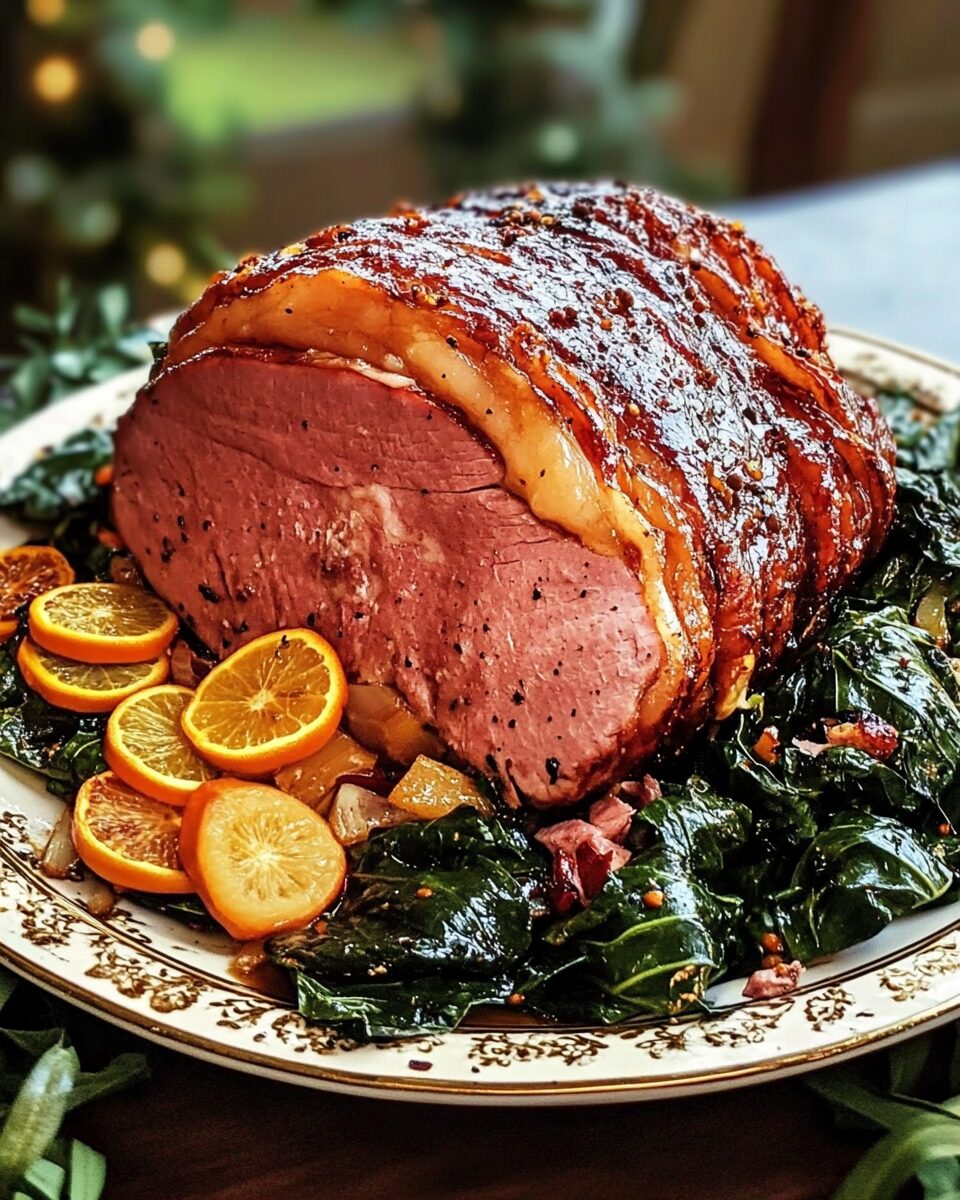The Magic of Madeira Wine in Cooking
Madeira wine is a fortified wine from Portugal’s Madeira Islands, known for its deep, complex flavors and rich caramel notes. It adds a distinctive depth to the glaze, complementing the sweetness of the honey while also enhancing the smokiness of the ham.
One of the reasons Madeira is such a great choice for cooking is its high acidity and slightly nutty, roasted character, which balances well against the richness of the ham. When reduced with honey and spices, it creates a luscious glaze that clings to the ham, forming a golden, glossy crust as it roasts.
Why Smoked Ham Works Best
The key to this recipe is starting with a high-quality, bone-in smoked ham. A good smoked ham, particularly one made from heritage breeds like Berkshire, has a superior texture and flavor, with a natural sweetness that pairs beautifully with the Madeira glaze.
- Bone-in ham retains more moisture during cooking, ensuring the meat stays juicy and tender.
- Smoked ham already has a deep, savory flavor that is enhanced rather than overpowered by the glaze.
- The scoring process allows the glaze to penetrate the meat, ensuring every bite is packed with rich, aromatic goodness.
The Importance of Scoring the Ham
Before roasting, the surface of the ham is scored in a crosshatch pattern. This technique serves several purposes:
- It allows the glaze to seep into the ham, infusing it with maximum flavor.
- It creates a beautiful, textured appearance as the glaze caramelizes.
- It helps render excess fat, ensuring a crispy, flavorful exterior.
As the ham roasts, the scored areas expand, forming crispy, golden edges that contrast beautifully with the tender, juicy interior.
Aromatic Glaze with Perfectly Balanced Flavors
The Madeira glaze is what truly elevates this dish, creating a rich, glossy coating that enhances both the flavor and presentation of the ham. The key ingredients work together harmoniously:
- Madeira wine adds depth, acidity, and a slight caramelized sweetness.
- Honey provides a natural sweetness that balances the saltiness of the ham.
- Black peppercorns introduce a mild heat that cuts through the richness.
- Coriander seeds lend a citrusy, slightly floral note that brightens the glaze.
This combination results in a glaze that is both sweet and savory, with layers of flavor that develop and intensify during roasting.
Slow Roasting for Maximum Flavor
Roasting at a moderate temperature allows the ham to cook evenly while the glaze slowly caramelizes. Basting the ham with the glaze throughout the process ensures that every inch is coated in its rich, aromatic goodness.
- Low and slow roasting prevents the ham from drying out.
- Basting every 20–30 minutes builds up layers of sticky, flavorful glaze.
- Resting the ham after roasting allows the juices to redistribute, keeping the meat tender and moist.
The final result is a ham that is glistening, deeply caramelized, and infused with warm, spiced flavors.
A Built-In Side Dish: Collard Greens and Roasted Aromatics
One of the most unique aspects of this recipe is that the ham is roasted on a bed of collard greens, leeks, and tangerines, which soak up the drippings and become a delicious side dish.
- Collard greens absorb the smoky, meaty juices from the ham, giving them a deep, savory flavor while maintaining their hearty texture.
- Leeks soften as they roast, adding a mild, sweet onion-like taste that enhances the dish.
- Tangerines provide a subtle citrus brightness, balancing the richness of the ham and greens.
This method not only simplifies meal prep but also ensures that no flavor goes to waste—every element of the dish is infused with the essence of the Madeira-glazed ham.
Perfect for Holidays and Special Gatherings
This Madeira-glazed ham is an ideal dish for festive occasions, making a stunning centerpiece that is both visually impressive and incredibly delicious. Whether served at Thanksgiving, Christmas, Easter, or a celebratory dinner, it’s guaranteed to be a crowd-pleaser.
- Easy to prepare: Once the glaze is made, the oven does most of the work.
- Feeds a crowd: A single ham can serve multiple guests, making it perfect for gatherings.
- Pairs well with a variety of sides: While the collard greens make a fantastic accompaniment, the ham also pairs beautifully with roasted potatoes, sweet potato mash, or a fresh citrus salad.
Tips for the Best Madeira-Glazed Ham
To get the most out of this recipe, keep these expert tips in mind:
- Choose a high-quality ham: A well-marbled, smoked bone-in ham will yield the best texture and flavor.
- Let the ham come to room temperature before roasting: This ensures even cooking.
- Use a roasting rack if needed: If you prefer not to roast the ham directly on the greens, a rack can help elevate it while still allowing the drippings to flavor the vegetables below.
- Don’t skip the resting period: Allowing the ham to rest before slicing helps retain its juices, keeping it moist and tender.
- Save the leftovers: Leftover ham can be used in sandwiches, soups, or even breakfast dishes like omelets and hash.
Customizing the Recipe
This Madeira-glazed ham recipe is highly adaptable, allowing for personal touches and variations:
- Use a different glaze: Swap the honey for maple syrup or brown sugar for a slightly different sweetness.
- Add extra spices: A pinch of cloves or cinnamon can enhance the warm, spiced notes of the glaze.
- Try different greens: Instead of collard greens, experiment with kale or Swiss chard for a different texture.
- Include more citrus: Orange or grapefruit slices can be used alongside the tangerines for an extra citrusy kick.
Conclusion
Madeira-glazed ham is more than just a main course—it’s an experience. With its glistening, caramelized crust, rich aromatic flavors, and built-in side of savory greens, this dish is a showstopper that is as delicious as it is beautiful. The combination of smoky ham, sweet Madeira glaze, and tender roasted vegetables creates a perfectly balanced meal that’s ideal for special occasions.
Whether you’re hosting a holiday feast or simply looking for an impressive dish to serve your guests, this ham will undoubtedly become a favorite. With its deep, smoky-sweet flavor and stunning presentation, it’s a recipe that brings warmth, comfort, and a touch of elegance to any table. Enjoy!






